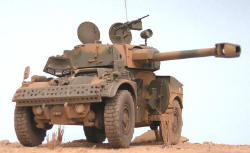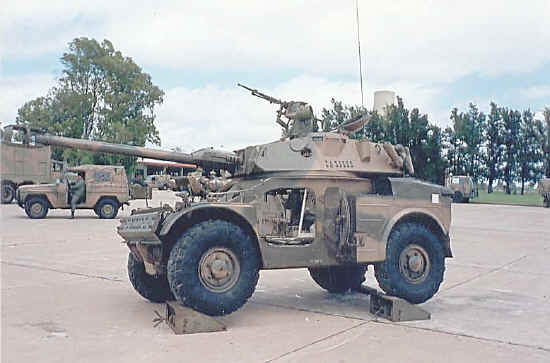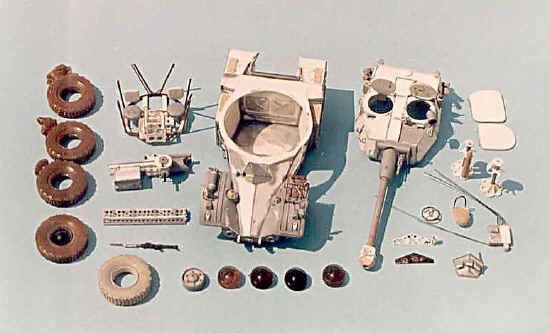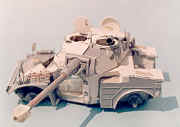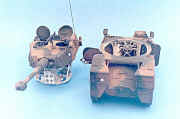 |
|||||||||||||||||||||||||||||||||||||||||||||||||||||||||||
|
Armor |
|
||||||||||||||||||||||||||||||||||||||||||||||||||||||||||
|
Argentine Army (EA) AML 245 Panhard H-90 1/35 scale |
|||||||||||||||||||||||||||||||||||||||||||||||||||||||||||
|
by Juan Carlos Heredia |
|||||||||||||||||||||||||||||||||||||||||||||||||||||||||||
|
"Get information from the enemy through combat". This is the slogan of the "Exploración de Caballería" units, that the AML 245 (Automitrailleuse Légere) accomplished during its service history in the Middle East, Africa, Central America and Malvinas / Falklands. Designed by the French company Panhard during the 60´s as an exploratory fire support vehicle, based on the experience obtained in the Algeria war, this unit gave origin to a whole family of armored vehicles with different versions equipped as tank fighters, mortar carriers, antiair system, surveillance radar, missile launcher and troop carrier. The most widely known AML is the H-90 which has, among all armored vehicles, the best relationship between fire power and size of the vehicle, with a 90 mm gun for a 5,5 ton weight. This small auto cannon with enough fire power to defeat heavier combat tanks, high speed and low cost, was adopted by 35 countries worldwide. More than 5000 units were manufactured during 30 years and it will continue in operation for many years to come.
The PANHARD in Argentina In 1977 Argentina acquired 60 AML units, version H-90, to be sent to the Exploration Squadrons and Headquarters of the Argentine Army. In 1982, they were the only armored vehicles used by our Army during the Malvinas / Falklands War. Due to the blockade imposed by the British, the delivery of a whole unit of SK-105 Kürassier was not carried out, instead 12 Panhard AML-90's were transported by air to the islands: eight units from the 181st Exploration Corp based in Esquel, two units from the 9th Exploration Squadron in Puerto Deseado and two others from the 1st Squadron in Arana, La Plata. The crews soon discovered that they would not only have to confront the British but also the particular features of the terrain, which was inconsistent, covered with a light coat of peat on the mud, where the wheels would loss traction and the vehicles would swamp up to their axes. This, plus the lack of good roads simply neutralize the capacity of the Panhard units. They were just used as simple static cannons. With the passage of time, other drawbacks will also appear: low temperatures and constant humidity that seriously damaged the batteries and the electric system, lack of fuel, which was primarily assigned to the electrical groups of the air defense radar, the counterbattery fire of the British, the control of the air by the enemy and the lack of night sights in the shooting system of the Panhard which were absolutely necessary due to the short hours of light in the Malvinas /Falklands winter and during combats, since the British always carried out their attacks at night. Until the surrender on June 14th, two AML's had been damaged by gunfire splinters, although in other circumstances they could have been repaired. The rest of them were disabled by their crews who decided to destroy the lock of their guns and engines. Despite this fact, the British managed to put two Panhards back in service and carried them to England. Nowadays, the EA 33524 "Tcnl. Olascoaga" is being exhibited at the Tank Museum in Bovington, Dorset. In January 1989, the Panhard units also took part in the actions for the recovery of the headquarters belonging to the "Regimiento de Infantería 3" in La Tablada which had been taken by terrorist forces. The kit There´s a 1/35 kit manufactured by the Spanish firm KMR but its parts are too big so I discarded this kit and chose my own model or scratch. The design of the AML, with wide lateral gates and hatches let us see clearly all interior parts and is good for detailing. The basic materials are 0,5 mm plastic for the chassis and turret, plastic pipes for the gun and others and copper wire of different diameters. The wheels were taken from a Mowag Piraña by Italeri. The appropriate pattern on the tires was produced with epoxy putty and then reproduced with plastic resin. Some small parts like lights and nuts were copied from other kits while the inner parts, dashboards, pilots cockpit, turret, gun block, etc were produced with the most important material used by modelers: ....patience.
Paints and markings The Panhard units have the typical color scheme of the Argentine Army: olive green and earth brown, with some shade variations according to the batches of paint, weathering, operational conditions, etc. The ID number, and sometimes an allegoric name, can be seen at both sides of the turret painted in black. This model represents the Panhard H-90 EA 33526 from the "Escuadrón de Exploración de Caballería Blindado Nº 1 Cnl. Don Isidoro Suárez", whose picture was taken at an open door exhibition in Arana, La Plata, in 1994.
Support us ordering our notes in PDF > Here |
|||||||||||||||||||||||||||||||||||||||||||||||||||||||||||
